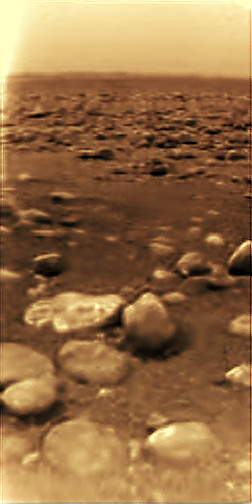- My Forums
- Tiger Rant
- LSU Recruiting
- SEC Rant
- Saints Talk
- Pelicans Talk
- More Sports Board
- Fantasy Sports
- Golf Board
- Soccer Board
- O-T Lounge
- Tech Board
- Home/Garden Board
- Outdoor Board
- Health/Fitness Board
- Movie/TV Board
- Book Board
- Music Board
- Political Talk
- Money Talk
- Fark Board
- Gaming Board
- Travel Board
- Food/Drink Board
- Ticket Exchange
- TD Help Board
Customize My Forums- View All Forums
- Show Left Links
- Topic Sort Options
- Trending Topics
- Recent Topics
- Active Topics
Started By
Message
New images of Saturn's moon Titan stitched together from infrared observations
Posted on 7/20/18 at 9:56 pm
Posted on 7/20/18 at 9:56 pm
LINK
Looks awesome and we are getting new stuff from the data sent back from the best probe ever.
Cassini team members created the six-image set using data collected over 13 years by the Saturn-orbiting probe's Visual and Infrared Mapping Spectrometer (VIMS). As its name suggests, VIMS deals in long-wavelength infrared light, allowing the instrument to see through the thick Titanic haze that obscures visible-light views of the moon's frigid surface.
Cassini scientists have created VIMS mosaics before, but those previous efforts generally had prominent seams, NASA officials said. Such seams naturally result from the stitching together of images snapped during different Titan encounters, which featured different lighting conditions and flyby angles
This is how it looks in regular visual light:

And here is the new stitched together infrared photos:

Wiki on Titan
Titan is the largest moon of Saturn. It is the only moon known to have a dense atmosphere, and the only object in space, other than Earth, where clear evidence of stable bodies of surface liquid has been found.
Size comparison with Earth:

Looks awesome and we are getting new stuff from the data sent back from the best probe ever.
Cassini team members created the six-image set using data collected over 13 years by the Saturn-orbiting probe's Visual and Infrared Mapping Spectrometer (VIMS). As its name suggests, VIMS deals in long-wavelength infrared light, allowing the instrument to see through the thick Titanic haze that obscures visible-light views of the moon's frigid surface.
Cassini scientists have created VIMS mosaics before, but those previous efforts generally had prominent seams, NASA officials said. Such seams naturally result from the stitching together of images snapped during different Titan encounters, which featured different lighting conditions and flyby angles
This is how it looks in regular visual light:

And here is the new stitched together infrared photos:

Wiki on Titan
Titan is the largest moon of Saturn. It is the only moon known to have a dense atmosphere, and the only object in space, other than Earth, where clear evidence of stable bodies of surface liquid has been found.
Size comparison with Earth:

This post was edited on 7/20/18 at 9:57 pm
Posted on 7/20/18 at 9:59 pm to DavidTheGnome
This is the first time one of your threads will keep people in stitches
Posted on 7/20/18 at 10:00 pm to DavidTheGnome
quote:
the best probe ever
Leave my penis out of this
Posted on 7/20/18 at 10:03 pm to DavidTheGnome
But what does it mean?????!!!!
Posted on 7/20/18 at 10:04 pm to DavidTheGnome

Why does the moon have a giant arse wart?
Posted on 7/20/18 at 10:05 pm to DavidTheGnome
quote:
best probe ever.
2nd best IMO
Posted on 7/20/18 at 10:06 pm to DavidTheGnome
Titan’s name was LucasP.
Posted on 7/20/18 at 10:10 pm to PrivatePublic
Info on Titan
Huygens Probe
Huygens was an atmospheric entry probe that landed successfully on Saturn's moon Titan in 2005. Built and operated by the European Space Agency (ESA), it was part of the Cassini–Huygens mission and became the first spacecraft ever to land on Titan and the farthest landing from Earth a spacecraft has ever made.[2] The probe was named after the Dutch 17th-century astronomer Christiaan Huygens,[3] who discovered Titan in 1655.
What the lander looks like:

Surface shot when it landed on it:

Huygens Probe
Huygens was an atmospheric entry probe that landed successfully on Saturn's moon Titan in 2005. Built and operated by the European Space Agency (ESA), it was part of the Cassini–Huygens mission and became the first spacecraft ever to land on Titan and the farthest landing from Earth a spacecraft has ever made.[2] The probe was named after the Dutch 17th-century astronomer Christiaan Huygens,[3] who discovered Titan in 1655.
What the lander looks like:

Surface shot when it landed on it:

Posted on 7/20/18 at 10:12 pm to DavidTheGnome
Keep thinking that's real.
Posted on 7/20/18 at 10:13 pm to DavidTheGnome
I’d like to see some new images of Sierra’s moon
Posted on 7/20/18 at 10:39 pm to tigerjjs
It means we have even prettier pictures of an uninhabitable world covered in nasty-arse methane. Maybe we can send robots to mine it, that's probably about it.
Posted on 7/20/18 at 10:39 pm to DavidTheGnome
Wonder if Tony Stark and Nebula are still stuck there
Posted on 7/20/18 at 10:55 pm to Woodreaux
quote:
It means we have even prettier pictures of an uninhabitable world covered in nasty-arse methane. Maybe we can send robots to mine it, that's probably about it.
I think learning about these moons/planets/etc is important not from a what do we get out it’s sake but furthering space exploration and expanding human knowledge of what’s out there. There’s value in learning just for the sake of learning. Galileo put his scope to the sky which started exploration of the heavens to where we now can see stars orbiting the black hole at the center of the universe, know that our galaxy isn’t all that’s out there, that space itself is not just expanding but accelerating away.
Being part of that discovery is what we get out of it and why I think we should invest far more than we actually do for these probes, telescopes, etc. I feel the same way with exploring the oceans.
Posted on 7/20/18 at 11:08 pm to DavidTheGnome
And I guess for example the US space program has given us the New Horizons probe that has turned Pluto from being a blurry dot to this


Posted on 7/21/18 at 1:38 am to DavidTheGnome
quote:
New Horizons probe that has turned Pluto from being a blurry dot to this
I thought Pluto wasn't a real planet but just a gaseous blob...….. It's all so confusing.
Posted on 7/21/18 at 2:45 am to DavidTheGnome
What does this have to do with flat earth?
Posted on 7/21/18 at 5:56 am to DavidTheGnome
Very cool.
I have a minor personal connection to Cassini. My undergrad major was Physics (and I did a good bit of study in Astronomy as well) at UT-Austin. My senior year I had an undergrad assistantship with a professor who was doing some of the preliminary design work on Cassini (and on what would become VIMS specifically).
I didn't make any major contributions myself but do remember that keeping the infrared sensor cool enough was a major design problem. In order to do infrared detection you need a very cold detector, and the RTG was expected to generate too much heat for this to work. Obviously they figured out a solution.
Although my time there was quite brief I did get to meet Sally Ride, who was heavily involved in the mission design study.
I have a minor personal connection to Cassini. My undergrad major was Physics (and I did a good bit of study in Astronomy as well) at UT-Austin. My senior year I had an undergrad assistantship with a professor who was doing some of the preliminary design work on Cassini (and on what would become VIMS specifically).
I didn't make any major contributions myself but do remember that keeping the infrared sensor cool enough was a major design problem. In order to do infrared detection you need a very cold detector, and the RTG was expected to generate too much heat for this to work. Obviously they figured out a solution.
Although my time there was quite brief I did get to meet Sally Ride, who was heavily involved in the mission design study.
Popular
Back to top


 11
11











